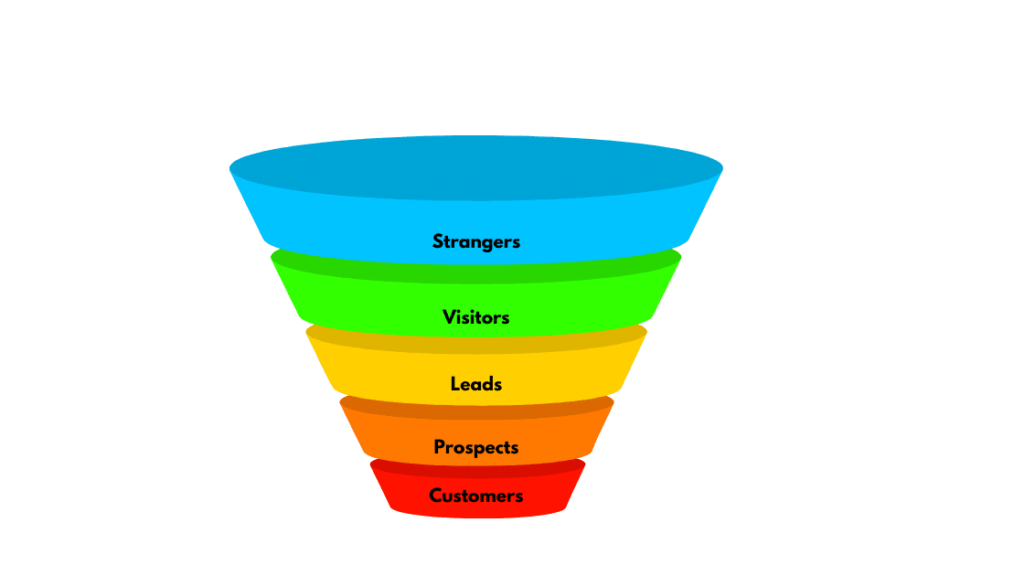If your Instagram or Facebook feed is anything like mine, its full of people either trying to sell me a journal I can take for long walks on the beach (while “smashing my goals”) or someone at a whiteboard full of equations and a diagram of a funnel similar to the one below
While I can’t speak to the value of long walks with your journal, I can give a crash course into marketing funnels. (and I promise not to pitch you my marketing funnel program or software that makes you money while you sleep).

Typical marketing funnel
At its best, a well-designed marketing funnel allows marketing and sales to work together more closely. It should provide clear and measurable feedback that allows adjustments to be made at each step of the customer’s journey.
- Strangers (marketing)
This is your target audience. Where your ideal customer lives but is currently unaware of your existence. The goal at this stage is to simply get your target audience to visitor your website and learn more about your business. The most effective advertising methods here generally involve pleasure or pain avoidance. How will the customer benefit from your service or product in a way that gives them some kind of pleasure, or helps them avoid some kind of pain. (this is a huge topic in its own right!)
– Metric: Website Visitors
- Visitors (marketing)
Very few visitors will leap from this stage right the way through to customers. Most strangers need to learn more about you and your business before making a financial commitment. Obviously the price point of your product or service will play a part as well. At a minimum the goal of this stage is to begin to form a relationship. This is often achieved through the capturing of email addresses. (again this is another massive topic in its own right)
– Metric: Email addresses
- Leads (marketing)
This is the relationship building phase. Depending on your business this could mean simply remaining in contact with your prospective customer in the form of regular newsletters, or a more sophisticated drip marketing campaign. At this stage a larger proportion of your potential buyers will skip the next stage and make a purchase. This is often the case in ecommerce sales where the simple act of regular reminders is enough to prompt purchases. In service businesses the goal at this stage is most often just to simply move the subscriber to the next stage in the funnel. In other words the goal is to get the reader to take action.
– Metric: Purchase / Booking
- Prospects (sales)
In larger companies this is the stage where sales is handed the baton usually in the form of appointments or calls. In smaller businesses, where the same person wears multiple hats, this is the point at which the relationship becomes more meaningful. The conversation becomes increasingly specific, whether verbally or written, as both parties determine if they’re a good fit for one another. This point in the process can see people return to stage 3 if they’re not quite ready to make a commitment, which is perfectly normal. The true goal of this stage is of course to make a sale.
– Metric: Purchase
- Customers (sales)
Although this is the end of the funnel it shouldn’t be the end of the marketing journey. Even in the rare circumstances where customers are making a single purchase. (wedding photography??) there is still the potential benefit of turning them into fans who can refer new customers. Referrals and repeat customers are always the most profitable part of any marketing campaign. Taking time to plan your future communications with customers is extremely valuable.
– Metric: Revenue!
Any size business will benefit enormously from a well-defined marketing funnel. There’s something about the visual format that really helps clarify marketing strategy. But more than that the defined steps make it so much easier to create specific goals for each part of the buyer’s journey. Measuring the success of an ad campaign or new website can be directly linked to the targets you set out within your funnel.
Do you need new software?
It’s totally possible to design a marketing funnel and operate it within independent silos of information. Google, Facebook, Google Analytics, CRM, Email, etc etc. All of them normally offer statistics you can link directly to the stages of your funnel. That said, it can be a time-consuming process that shouldn’t be undertaken by anyone who isn’t reasonably comfortable with software administration.
A potentially better solution (although more expensive, depending on the software) is to invest in marketing automation. Unfortunately (at least when it comes to taking the first step) the popularity of this software category has produced a mind-boggling 500+ different providers and shows no signs of slowing down.
So where should you start right now?
My advice would be to start with the basics, which means choosing some email marketing software that lets you do at least 3 key things:
- Capture email addresses directly from your website or blog.
- Store email addresses securely and segment them for personalisation (basically this means you can tag your subscribers in some way so you know what they’re interested in).
- Send email safely to your recipients (email software with a bad reputation often fails to deliver email to your subscribers).




